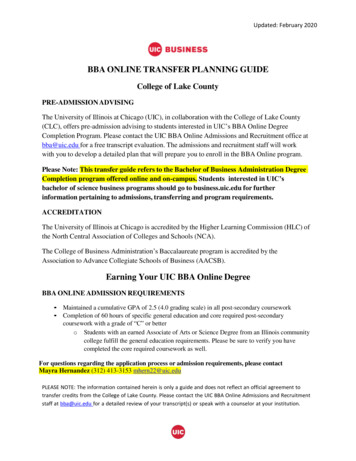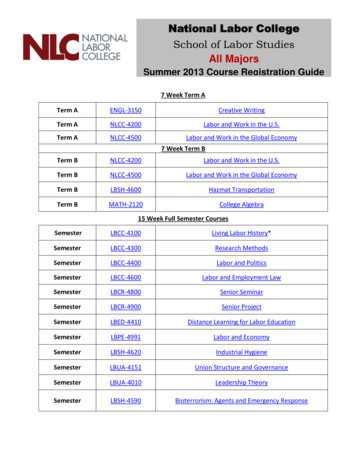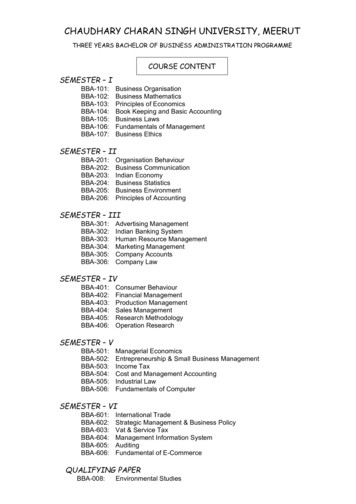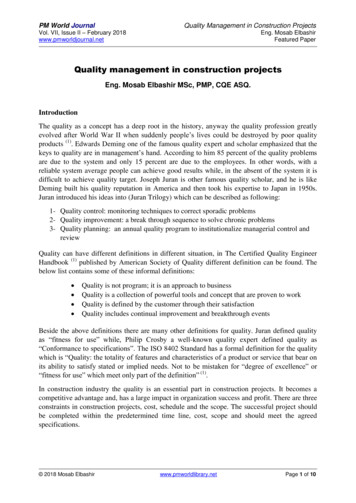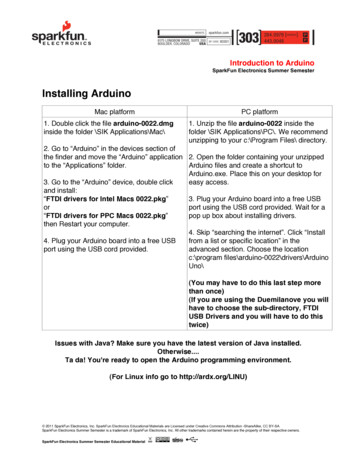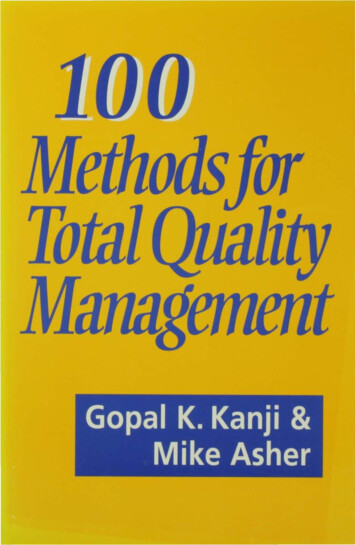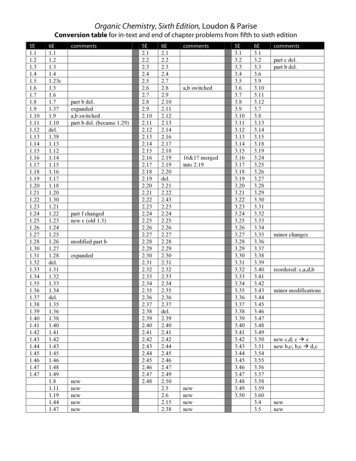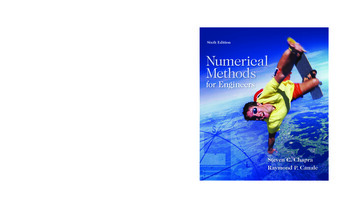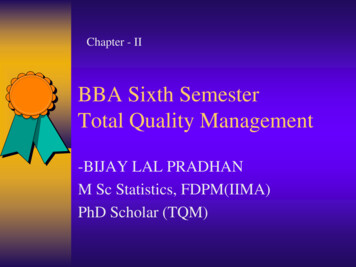
Transcription
Chapter - IIBBA Sixth SemesterTotal Quality Management-BIJAY LAL PRADHANM Sc Statistics, FDPM(IIMA)PhD Scholar (TQM)
Syllabus Introduction to Quality and Qualitymanagement Conceptual Frameworks for TotalQuality Management (TQM) TQM Tools Six Sigma Quality System Standards
Total Quality Management Chapter-2 Conceptual Framework for TQM
Conceptual Frameworks forTotal Quality Management Early TQM Frameworks and Concepts:Deming‘s fourteen points, Juran‘s ten steps,Corsby‘s four absolute and fourteen steps tomanage improvement, Feigenbaun‘sapproach to total quality control, Concepton Kaizen‘s tools—PDCA, 5s, 7 wastes, 7old and new quality tools, 5 whys, valuestream mapping,
Conceptual Frameworks forTotal Quality Management Workstation improvement and successstories, Shigeo Shingo‘s approach—Zeroquality control, Just-In-Time(JIT), andSingle Minute Exchange of Dies(SMED), Garvin‘s eight qualitydimensions, Ishikawa (Fishbone)diagram, Taguchi‘s philosophy toquality, The common causes of TQMfailures
Development of QualityTotal QualityManagmentQualityAssuranceQuality ControlInspection
Characteristi Inspectioncs1800SSQC 1930sPrimaryconcernView ofQualityEmphasisDetectionControlA ProblemTo be solvedQualityTQM 1980 Assurance1950sCoordination ManagementProactiveattackDesignersroleA competitiveopportunityProductUniform productThe market anduniformitywith cal quality ProgramsStrategicmeasurement toolsand systems planning, goalsettingWho isInspectionManufacturing and AllEvery (Team)responsibledept.engineeringDepartments one in ols qualityBuilds inManages inand approach qualityqualityquality
Introduction Total – Made up of the whole(or) Complete. Quality – Degree of Excellence a product or serviceprovides to the customer in present and future. Management – Act , art, or manner of handling ,controlling, directing, etc.TQM is the art of managing the whole to achieveexcellence.8
"TQM is a management approach for anorganization, centered on quality, based on theparticipation of all its members and aiming atlong-term success through customer satisfaction,and benefits to all members of the organizationand to society."DefinitionTQM is composed of three paradigms:Total: Organization wideQuality: With its usual Definitions, with all itscomplexities (External Definition)Management: The system of managing with stepslike Plan, Organise, Control, Lead, Staff, etc.9
DefinitionTotal Quality Management(TQM) is a management strategyaimed at embedding awareness ofquality in all organizationalprocesses.10
ExplanationTQM requires that the companymaintain this quality standard inall aspects of its business.This requires ensuring that thingsare done right the first time andthat defects and waste areeliminated from operations.11
Guru‘s of TQM Walter.A.Shewhart -TQC W.Edwards Deming- 14 Points &PDCA Joseph.M.Juran-Juran‘s Trilogyand Ten steps A.Feiganbaum-Customerrequirement, EmployeeInvolvement, TQC.12
TQM concept from Quality Gurus Edward Deming– Father of Quality Management– PhD in physics– keen statistician– US government in the department ofAgriculture and the Bureau of Census– 1950, Japan, Course on Quality Control– Japanese embraced the notion of quality underDeming‘s inspiration.
Deming Deming believes in continuousimprovement. He also believes that theconsumer is the most important part of aproduction line. Meeting and exceeding thecustomers‘ requirements is the task thateveryone within the organization needs toaccomplish with total commitment.Furthermore, Deming believes in the use ofstatistical process control (SPC) charts asmajor method for solving problems.
Deming’s Fourteen Points1. Create constancy of purpose to improveproducts and services2. Adopt a new philosophy for the neweconomic age, with management learningwhat their responsibilities are andassuming leadership for change3. Cease dependence on mass inspection toachieve quality, by building quality intothe product
Deming’s Fourteen Points4. End the awarding of business on price;award business on total cost and movetowards single suppliers5. Improve constantly and forever the systemof production and service6. Institute training on the job7. Institute leadership with the aim ofsupervising people to help them to dobetter job.
Deming’s Fourteen Points8. Drive out fear so that everyone can workeffectively together for the organization9. Break down barriers between departments.Encourage research, design, sales andproduction to work together to foreseedifficulties belong to the whole system10. Eliminate slogans, exhortations andnumerical targets for the workforce sincethey are divisive, given that difficultiesbelong to the whole system
Deming’s Fourteen Points11. Eliminate quotas or work standards andmanagement by objectives or numericalgoals; leadership should be substitutedinstead12. Remove barriers that rob people of theirright to pride in their work13. Encourage education and selfimprovement for everyone14. Take action to accomplish thetransformation
The first three principles clearly focus onthe cultural aspects of the organization. The fourth principle focuses on thecustomer relationship The fifth principle is aimed for continuousimprovement The sixth, seventh and eighth principles arerelated to human relationships andmanagement style The ninth principle can be seen as linked toprinciple, a way for breaking down barriers.
The tenth principle, eliminate slogans,exhortation and numerical quotas. setting of targets and quotas is potentiallymeaningless and divisive unlessaccompanied by a specific action plan toimprove the process. giving the work force a chance to work withpride. The idea of principle thirteen iscontinuously improve The final principle is to put everyone towork to achieve the transformation.
Deming Action Plan1. Management must agree on the meaning of thequality programme, its implications and thedirection to take2. Top management must accept and adopt the newphilosophy3. Top management must communicate the planand the necessity of it to the people in theorganization4. Every activity must be recognized as a step in aprocess and the customers of that processidentified; the customers are responsible for thenext stage of the process.
Deming Action Plan5. Each stage must adopt the ‗Deming‘ or ‗Shewart‘cycle -Plan, Do, Check, Action- as the basis ofquality improvement6. Team working must be engendered andencouraged to improve inputs and outputs,everyone must be enabled to contribute to thisprocess7. An organization for quality must be constructedwith the support of knowledgeable statisticians
Joseph M. Juran 1924, Engineer Worked as civil servant, executive,,academic, arbitrator, director andmanagement consultant. Quality Control Handbook 1950 Movement of Quality in Japan
Quality TrigologyQuality TrilogyQuality planningQuality controlQualityimprovementDefinitionThe activity of developing theproducts and processes required tomeet customers’ needs.This process deals with execution ofplans, conducting operations to meetthe goalsThis process is the means of raisingqualityperformancetounprecedented level.
Juran‘s Ten Steps1. Build awareness of the need and2.3.4.5.opportunity for improvement.Set goals for improvement.Organize to reach the goals (establish aquality council, identify problems, selectprojects, appoint teams, designatefacilitators).Provide training.Carry out projects to solve problems.
Juran‘s Ten Steps6. Report progress.7. Give recognition.8. Communicate results.9. Keep score10. Maintain momentum by making annualimprovement part of the regular systemsand processes of the company.
Philip B. Crosby Graduate of the Western Reserve University After military service Quality control in manufacturing, Line inspector to quality director Philip Crosby Associates Incorporated andthe Quality College based in Florida.
Four AbsoluteFirst Absolute :Second Absolute :Third AbsoluteFourth Absolute :The definition of quality isconformance to requirements, notgoodness.The system for causing quality ispreventive, not appraisal.The performance standard must bezero defect, not ―that‘s closeenough‖.The measurement of quality is theprice of non – conformance, notindexes
Crosby’s Fourteen StepsStep 1 : Establish and ensure managementcommitment. It is vital that the wholemanagement team participate in the programme.Step 2 : Form quality improvement teams(QITs) for quality improvement processplanning and administration. The emphasis hereis on multidisciplinary team effort. An initiativefrom the quality department will not besuccessful. It is essential to build team workingacross arbitrary; and often artificial,organizational boundaries.
Crosby’s Fourteen StepsStep 3 : Establish quality measurements. Thesemust apply to every activity throughout thecompany. A way must found to capture everyaspect, design, manufacturing, delivery, and soon. These measurements provide a platform forthe next step.Step 4 : Evaluate the cost of quality andexplain its use as a management tool tomeasure waste. This evaluation must highlight,using the measures established in the previousstep, where quality improvement will beprofitable.
Crosby’s Fourteen StepsStep 5 : Raise quality awareness among allemployees. This is normally undertaken throughthe training of managers and supervisors, throughcommunications such as videos and books, andby displays and posters.Step 6 : Take actions to correct problemsidentified through previous steps. This involvesencouraging staff to identify and rectify defects,or pass them on to higher supervisory levelswhere they can be addressed.
Crosby’s Fourteen StepsStep 7 : Establish a zero defects committee andprogramme. This is done by establishing acommittee or working group to develop ways toinitiate and implement a zero defects programme.Step 8 : Train supervisors and managers ontheir role and responsibilities in the qualityimprovement process. This step is focused onachieving understanding by all managers andsupervisors of the steps in the qualityimprovement programme in order that they canexplain these in turn.
Crosby’s Fourteen StepsStep 9 : Hold a zero defects day to reaffirmmanagement commitment. This can be achievedin a celebratory atmosphere.Step 10: Encourage individuals and groups to setimprovement goals. Goals are of course of novalue unless they are related to an appropriatetimescale for their achievement.Step 11: Obstacle reporting (i.e., encourageemployees to communicate to management anyobstacles they take in attaining theirimprovement goals).
Crosby’s Fourteen StepsStep 12: Recognize and appreciate allparticipants.Step 13: Establish quality councils to discussquality matters on a regular basis. These areessentially forums composed of qualityprofessionals and team leaders allowing them tocommunicate and determine action plans forfurther quality improvement.Step 14: Do it all over again to demonstrate thatthe improvement process never ends.Achievement of quality is an ongoing process.There is always further to go.
Armand V. Feigenbaum concept of Total Quality Control (TQC). His book ―Total Quality Control‖ was firstpublished in 1951 quality as a strategic business tool thatrequires involvement from everyone quality control as a measurement andevaluated tool. Quality begins with identification ofcustomers requirements and ends with aproduct or service in the hands of a satisfiedcustomer.
Ten attributes of Feigenbaum1. Total Quality control must be a companywide process. It is a system for integratingquality development, maintenance andimprovements efforts in an organizationthat will enable engineering, marketing,production and service to function atoptimal economic levels while achievingcustomer satisfaction.2. Quality is defined by the customer.
Ten attributes of Feigenbaum3. Quality and cost is a sum, not adifference. Operating quality costs can bedivided into four categories: preventioncosts, appraisal costs, internal failure costand external failure costs.4. Quality requires both individual and teamenthusiasm.5. Quality is a way of managing.6. Quality and innovation are interdependent.
Ten attributes of Feigenbaum7. Quality is an ethic.8. Enhanced quality demands continuousimprovement.9. Quality is the most cost-effective and leastcapital-intensive route to productivity.10. Quality is implemented with a total systemconnected with customers and suppliers.
Concept of Kaizan tools Kaizen is ongoing improvement whichinvolves everyone in the organization. Kaizen is a people-oriented approach tocompetitiveness continuous improvement will benefit theorganisation and in turn will benefit theindividual Continuous improvement focuses on thewhole process (means and the ends) ratherthan the results only
PDCA CyclePlan: Establish the objectives and processesnecessary to deliver result in accordance tocustomer‘s requirements and organizationspolicies.Do: Implement the process.Check: Monitor and measure process andproduct against policies, objectives andrequirement for the product and report result.Act: Take required actions to continuallyimprove process performance.
5SS.N Japanese English (5C)(5S)1 SeiriClear cut(organize)2 Seition Configuration(systematise)3 SeisoClean andcheck4 Seiketsu ConformMeaningDetermine what is necessary andunnecessary and dispose of the laterProvide a convenient, safe and orderlyplace for everything and keeping itthere.Monitor and restructure the conditionof working areas during cleaningSet standard, train and maintain.(standardisation)5 Shitsuke Custom andPractice(Discpline)Develop the habit of routinemaintenance and strive for furtherimprovement.
Points for successful 5 S Participation by all people The program requires top managementcommitment The CEO should take leadership of the program The program should be supported by all 5S program should be self sustaining The CEO should take a periodic factory tour inperson The program should generate sufficient impact atthe initial stage Implementation of 5S should so hand in hand withother kaizen program.
Waste of1. StockMeaningSeven Reduce Lead TimeStockingWastagesmore thanrequired2. WaitingWait of job to beperformed3. Over production Producing more thanrequired4. Transportation5. Processing6. Motion7. DefectiveproductsHow to control?Un-necessary materialDispatch & transport tolocationAll parts are processed ata time for productionMotion for productivity &quality consistency(Automating waste)More defective outputsmaking Improve skill of workerJIT productionsBalance and even loads to the equipmentsFlexible workers Fair prediction of demandReducing set up times.Use of small specialized production ratherthan large.Efficient material handling system.Better location layout decision. Put into process what is required only.Suitable technology Improve the motion and then applyautomationGroup Technology Quality at sourceTechnology improvementSkilled manpower
Tools for Quality Control Pareto Analysis Scatter Diagram Control Charts Flow Charts Cause and Effect , Fishbone, IshikawaDiagram Histogram Check Sheets
Parato Analysis 80 : 20 Rule Detection of Vital few
Restaurant ComplainsComplaintDiscourteousserverSlow serviceCold dinnerCramped tablesSmoky airFrequency124252010
Parato Chart
Scatter Diagram
Scatter Diagrams Scatter diagrams are used to represent andcompare two sets of data Plot points of pairs of observations has thevalues(X1,Y1), (X2,Y2), (X3,Y3), .(Xn, Yn).
Control Chart
Flow Chart
Cause Effect Diagram
Histogram or Bar Graph
Check-Sheet
Seven New QC tools numerical data cannot always adequatelyexpress the facts The Seven New Q.C Tools are Affinitydiagrams, Relation diagrams, Treediagrams, Matrix diagrams, Prioritiesmatrix, Arrow diagrams and Processdecision program charts.
Affinity Diagram It is a technique to generate ideas andlinkup with other ideas to form a commonidea which facilitates breakthrough thinkingand stimulate fresh ideas. The large number of ideas generated can begrouped according to their ―affinity‖ orrelationship to each other.
Affinity Diagram
Relation Diagram Relation diagram identifies and explorescasual relationships among related conceptsor ideas. It shows that every idea can be logicallylinked with more than one other idea Relation diagram is useful tools for findingappropriate strategies by relating differentcauses of a problem by identifying the rootcauses of the problem
Relation Diagram
Tree Diagram Tree Diagrams are drawn to develop asuccession of strategies/ means forachieving an objective (target, goal orresult) systematically and logically. Constructing this diagram yields specificguidelines for solving a problem. Tree Diagrams are also classified asstrategy-development or componentdevelopment diagrams.
Matrix Diagram Matrix diagram provides a picture of howwell two sets of objects or issues are relatedand can identify missing pieces in thethought process. The visual depictions canhelp managers set priorities on plan andactions.
Matrix g NewEnvironment TechnologyProducts
Priority Matrix This type of matrix is drawn when there aremany tasks but there are not enoughresources. So instead of just thinking whichtasks are more important, the PriorityMatrix is drawn. Matrix data analysis takes data and arrangesthem to display qualitative relationshipamong variables to make them more easilyunderstood and analysed. It is based on the ―factor analysis‖ ofStatistical techniques.
Priority MatrixBestOurCompetition CompanyEvaluation EvaluationRequirementImportantWeightPrice0.268 2Reliability0.478 1Delivery0.185-3Technicalsupport0.375-2Difference
Arrow diagram This is also known as activity networkdiagram and is similar to Critical PathMethod (CPM). It describes that who is going to do whatand when?, what can be done in parallel andwhat can be done only in series, one afteranother. This diagram is mostly used by planning aidfor construction projects and largemanufacturing units.
Arrow Diagram
Process decision programcharts (PDPC) Process decision program charts (PDPC) isa method for mapping out everyconceivable event and contingency that canoccur when moving from problem statementto possible solutions. PDPCs are used forplanning the activities needed to solveproblem when information is incomplete orthe situation is fluid and hard to forecast.
Example: The problem is that client, Suraj Imp., isunhappy. Using the 5 Whys, you go through thefollowing steps to get to the cause of the problem: 1. Why is our client, Suraj Imp., unhappy? Because we didn't 5whys deliver our services when we said we would.2. Why were we unable to meet the agreed-upon timeline orschedule for delivery? The job took much longer than wethought it would.3. Why did it take so much longer? Because weunderestimated the complexity of the job.4. Why did we underestimate the complexity of the job?Because we made a quick estimate of the time needed tocomplete it, and didn't list the individual stages needed tocomplete the project.5. Why didn't we do this? Because we were running behind onother projects. We clearly need to review our time estimationand specification procedures.
Value Stream Mapping Value Stream Mapping (VSM) is theprocess of mapping the material andinformation flows required to coordinate theactivities performed by manufacturers,suppliers and distributors to deliverproducts to customers. Not only the material flows but alsoinformation flows that signal and controlthe material flows.
VSM A typical VSM project involves thedevelopment of maps:(1) a Current State Map and(2) one or more Future State Maps thatrepresent progressive improvements in theCurrent State Map.
Workstation Improvement A reasonable industrial workstation designaffects not only the productivity but also thehealth of workers. In industrial workstation,the primary concern has usually been theimprovement of the performance of theequipment and then the matching theabilities of the operator with the taskrequirement. Many industrial workstationsare poorly designed, resulting in lowerworker productivity and unnecessary injuryat the workplace.
Workstation improvement The methods used in workstation improvementsimplify the work or working methods andmust go towards higher productivity. It isalways desirable to perform the requisite thefunction with desired goal with minimumconsumption of resources. Workstation isessentially concerned with finding better waysof doing things. It adds value and increases theefficiency by eliminating unnecessaryoperations, avoidable delays and other formsof waste.
Objective of WSI1. To improve work methods and procedures.2. To determine the best sequence of doing work.3. To smoothen material flow with minimum of backtracking and to improve layout.4. To improve the working conditions and hence toimprove labour efficiency.5. To reduce monotony in the work.6. To improve plant and material utilisation.7. Elimination of waste and unproductive operations.8. To reduce the manufacturing costs throughreducing cycle time of operations.
Shigeo Shingo’s approach-Zero QC Defects in production may be due toomitting processing (or operations),processing errors, equipment set-up errors,missing parts/component wrongparts/component and adjustment error A good process design prevents defects atall from occurring
ZQC consists of the following Source inspection: Checking for the factors thatcauses errors, not the resulting defect. 100 percent inspection: The operator inspects his orher own work 100 percent, or inexpensive Pokayoke (Poka means error and yokeru means prevent)devices inspect automatically for errors or defectiveoperating condition Immediate action: Stopping operations instantlywhen a mistake is made and not resumingoperations until the error is rectified. Feedback isprovided through successive checks, in which thenext person in the process immediately feedbackinformation to the supplying operator to stopproduction and fix the error
Just In Time JIT is known as the Japanese philosophy formanaging inventory. high volume of production by usingminimum inventory of raw materials andwork in progress JIT requires high level of quality at eachstage of production process, strong vendorrelations and fairly predictable demand forsmooth flow of work.
JIT JIT provides for the cost efficientproduction in an organization and deliveryof only the necessary parts in the rightquantity at the right time and place withusing the minimum of facilities. It integrated whole based on the principlesof continuous improvements andelimination of all kinds of waste
(i)What is JIT?A management philosophy; A set of methods(ii) What it does?Reduce wastageExposes bottle necks & problemsAchieves streamline production.(iii) How is does?Employees participationIndustrial engineeringContinuing improvement.Total quality control ; Small lot size
JIT(iv) What it assumes?Stable environmentFairly predictable demandStrong vendor relationEfficient employees
Single Machine Exchange of Die If the set-up time is long (high cost), thenmore products should be produced in onebatch in order to reduce set-up cost per unit.Operating like this has the effect of creatingmore inventories. 1980‘s Shigeo Shingo, of Toyota Motor Co.studied which ultimate objective was tochange a machine tool in less than 10 minutes
SMED To effect SMED procedures, the logic is toestablish the distinction between– External set-up : Machine is running and– Internal set-up : Machine is stopped In general, set-up times can be reduced by:– Locating required inventory and machine toolscloser to the operating area and– Standardising the set-up functions of machines.
Gravin‘s Eight Quality Dimension Performance: measurable primary characteristics ofa product or service Features: added characteristics that enhance theappeal of a product or service Conformance: meeting specifications or industrystandards Reliability: consistency of performance over time Durability: useful life of a product or service Serviceability: resolution of problems andcomplaints Aesthetics: the sensory characteristics of a productor service Perceived quality: subjective assessment of qualitybased on cues related to the product
Taguchi Philosophy Taguchi's main objective is to identify thefactors which are responsible for theproduct and the process variation andcontrol their settings to optimal level. Japanese quality expert known for his workin the area of product design. the method is applied in a systematic andscientific way at a pre-production stageoffline prior to the setting of themanufacturing process
Taguchi Philosophy Three steps in the engineering design cycle. System design: It is the basic prototype design that meetsperformance and tolerance specifications of the product. Itincludes section of materials, parts, components andsystem assembly. Parameter design: Given a system design, there aregenerally several parameters whose values need to bedetermined. One needs to find a functional relationshipbetween the parameter and the measure of performance ofthe system to determine an optimal value of the parameter. Tolerance design: The purpose of this is to determineallowable ranges of the parameters whose values areoptimized in parameter design stage. Achieving theoptimal value of a parameter may be very expensive,whereas a sub-optimal value could give the desired qualityat lower cost.
Common causes of TQM failure1.Absence or lack of top management’s commitment.2. Inadequate knowledge or understanding of TQMprinciples and methodology.3. Failure to accept TQM as a cultural revolution, i.e. achange in the organizational culture or the mind set of theemployees:4. Improper planning: Absence of long term vision,mission, and goals by the top management.Three components of successful TQM planning are(a) Obtaining company-wide commitment,(b) Communicating company vision, mission, and goals, and(c) Providing open communication about the company‘s newfocus.
Common causes of TQM failure5. Absence of continuous training and education6. Inadequate use of empowerment and team work:7. The Management related barriers are:(a) Fear of senior management losing control(b) Apprehension and doubts of the senior management,about the efficacy of the TQM methodology(c) Lack of leadership qualities(d) Failure in or faulty delegation of authority(e) Lack of motivation, at the senior level and(f) Managers do not support each other.8. Incorrect or insufficient or incompatible organisationalstructure and isolated individuals and departments, autocraticorganisational structure.
Common causes of TQM failure9. Inefficient or ineffective measurement techniques and lackof access to data and results10. The Customer related barriers may be listed as:(a) Inadequate attention to internal and external customersand the public.when a new product is launched(b) Lack of social responsiveness(c) Risks and benefits to the public are ignored or notevaluated.11. Inability to build a learning organization that provides forcontinuous improvement.
Total Quality Management Early TQM Frameworks and Concepts: Deming‘s fourteen points, Juran‘s ten steps, Corsby‘s four absolute and fourteen steps to manage improvement, Feigenbaun‘s approach to total quality control, Concept on Kaizen‘s tools—PDCA, 5s, 7 wastes, 7 old and new
